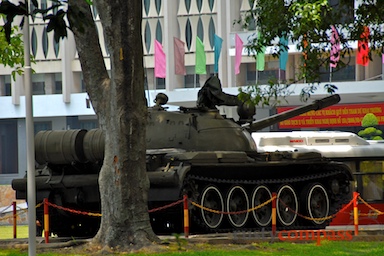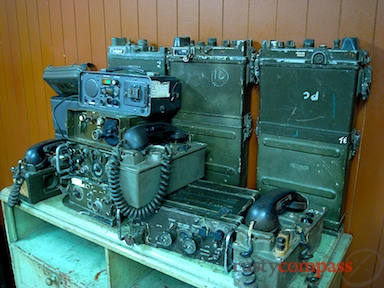The Reunification Palace is now open for travellers and has changed little since power was handed over to the communists from here on that fateful April day. It's an historic site with some war relics and wonderful 60s and 70s kitsch thrown in.

Photo: Mark BowyerA replica of tank 843, the first through the gates on 30 April 1975
The current building was commissioned by then President Ngo Dinh Diem in 1962 after the original palace was destroyed by an air attack from hostile elements in Diem's own airforce. Diem moved down the road to another of the former French Governor's premises which is now the Ho Chi Minh City Museum. He was assassinated in a coup by his own generals in November 1963. He never saw the finished palace he had commissioned.

Photo: Mark BowyerComms equipment in the palace basement
Thieu resigned from office under intense pressure on April 21 1975. The last nine days of the existence of South Vietnam saw two Presidents take the chair. Thieu's Vice President, the near blind and aged Tran Van Huong took over first before he too was replaced by Duong Van Minh also known as Big Minh. It was Minh who passed the baton to communist forces on April 30 after only two days in office. This event took place in the Cabinet room of the palace.
In a sign of the fragility of the South Vietnamese government, the palace was twice bombed by renegade members of the airforce over which it had command. On the first occasion in 1962, the pilot believed that President Diem was not taking an aggressive enough stance against the rising communist threat. Then in 1975 as the Republic collapsed, the palace was bombed again - this time by a pilot sympathetic to the approaching communists.
In addition to the historic scenes the palace played host to, it was also the stage for some bizarre personal twists.
South Vietnam's last president, Duong Van Minh (Big Minh) was the coup leader who deposed its first President, Ngo Dinh Diem - the man that commissioned the palace's creation. In April 1975, Bui Tin, the North Vietnamese colonel that witnessed the notional handover of power by Duong Van Minh to the victorious communists, ended up, like Big Minh, in exile in France where he still lives.
Address: 135 Nam Ky Khoi Nghia Street - District 1 - Ho Chi Minh City
Phone: (848) 38223652, 38290634‚ 3829411




There are no comments yet.